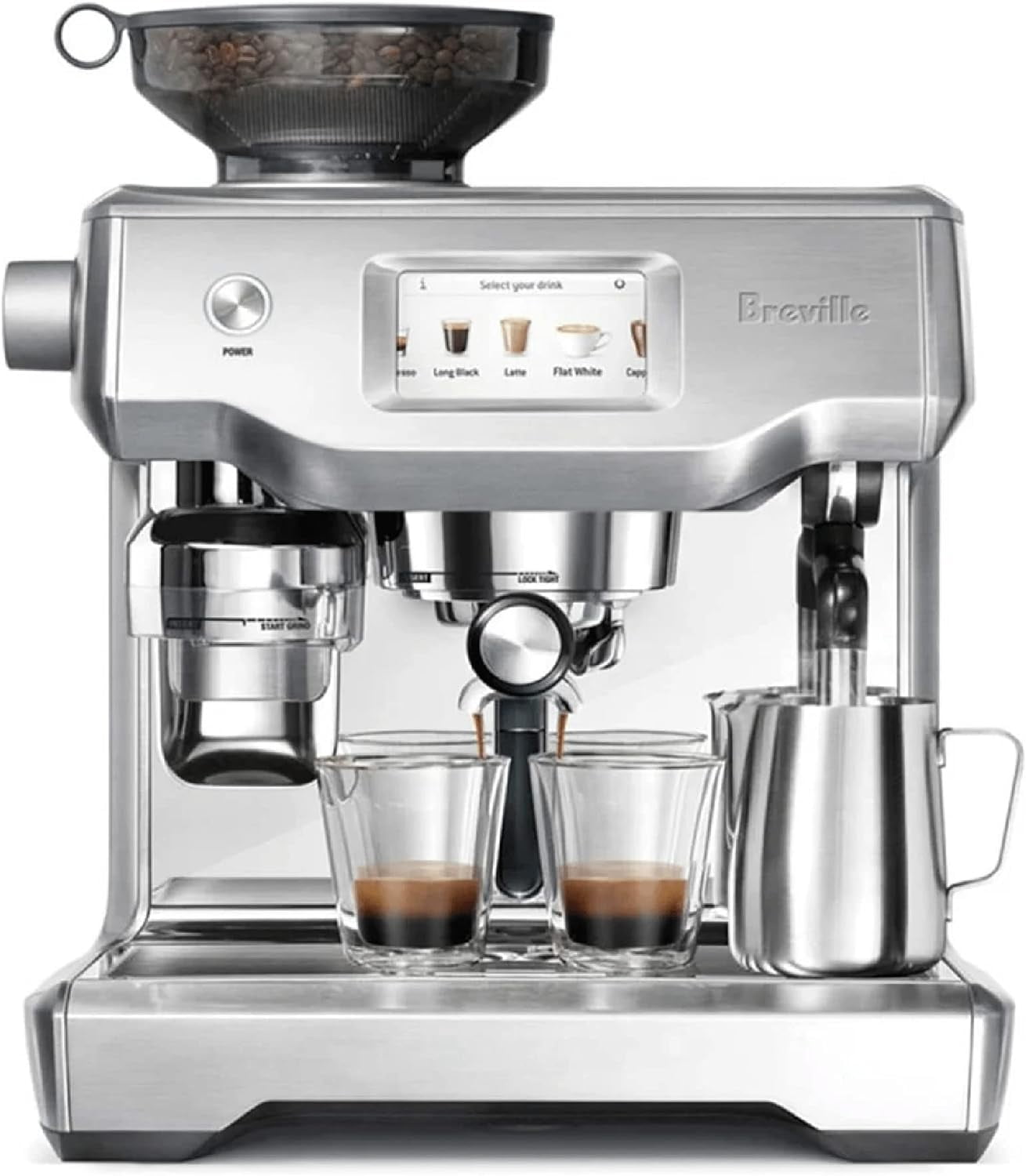#1: Breville Oracle
- Dual boiler system for simultaneous brewing and steaming
- Automatic grinding, dosing, and tamping
- Precise temperature control for consistent espresso
#2: Breville Oracle Touch

- Touchscreen for easy, customizable drink selection.
- Automated milk texturing for perfect froth.
- Fully automatic espresso process with user-friendly interface.
As a long-time coffee enthusiast and someone who's brewed countless espressos at home, I’ve had the chance to explore some of the best machines on the market. The Breville Oracle and Oracle Touch are two standout options that promise café-quality coffee in the comfort of your kitchen. After spending time with both machines, I’ve developed a deep appreciation for the craftsmanship and features each offers. However, the Breville Oracle, with its blend of manual control and automation, consistently delivers a more rewarding experience for a coffee lover like me.
Let’s dive deeper into what makes these machines tick, their standout features, and why the Breville Oracle has earned its place as my go-to recommendation for home espresso brewing.


Key Features: Breville Oracle vs. Oracle Touch
When comparing the Breville Oracle and Oracle Touch, it’s clear they share many core features. Both machines are equipped with dual boilers, integrated grinders, automatic tamping, and a steam wand that creates silky microfoam. These features ensure you can brew espresso and steam milk simultaneously, a must for crafting lattes or cappuccinos efficiently.
Where they differ is in their approach to user experience. The Oracle Touch emphasizes automation with its touchscreen interface, offering pre-programmed drink recipes that allow you to prepare a flat white or cappuccino with just a tap. While convenient, this automation takes away some of the manual engagement that I personally enjoy.
The Oracle, on the other hand, offers a more hands-on approach. With intuitive dials and buttons, it strikes the perfect balance between automation and manual control, letting you fine-tune your brew to match your taste preferences. For those who see coffee brewing as both an art and a science, this balance is invaluable. Know How to change the brew temperature on Breville/Sage Barista Express
Brewing Espresso: A Hands-On Experience
One of the things I appreciate most about the Breville Oracle is how it encourages you to become part of the brewing process. The ability to manually adjust settings like grind size, extraction time, and tamp pressure provides a level of customization that’s hard to beat. Over time, I’ve found this manual engagement has improved my understanding of espresso extraction and helped me refine my technique.
The Oracle Touch, by contrast, feels more like a “set it and forget it” machine. While that’s great for mornings when time is short, I find it less satisfying on weekends when I want to take my time crafting the perfect shot.
Who Benefits Most From Each Machine?
If you’re someone who values speed and convenience above all else, the Oracle Touch might be the better fit. Its touchscreen interface is intuitive and pre-programmed options make it easy for anyone, regardless of skill level, to brew café-quality drinks.
However, for those who enjoy the process of making coffee just as much as drinking it, the Breville Oracle is the clear winner. Its blend of automation and manual control allows you to experiment and truly master the art of espresso. Whether you’re dialing in a single-origin roast or perfecting your latte art, the Oracle provides the tools and flexibility to achieve exceptional results. Idea on How to steam milk on the Breville
Grinding and Tamping: Precision Made Easy
Both machines excel in grinding and tamping. Their integrated burr grinders and automatic tamping systems ensure a consistent dose every time. This consistency is crucial for achieving balanced espresso shots with rich flavors and a creamy crema layer.
That said, I found the Oracle’s manual grind adjustment a little more precise than the Oracle Touch’s automated options. This added control is especially useful when experimenting with different bean varieties or roast levels, where subtle adjustments can make a big difference in flavor.
Steaming Milk: Latte Art and Beyond
As someone who loves a good latte, the steam wand is an essential feature for me. Both machines produce excellent microfoam, ideal for latte art. However, the Oracle’s manual frothing mode gives me more control over milk texture, allowing me to create everything from silky smooth lattes to frothy cappuccinos.
While the Oracle Touch also allows manual frothing, it tends to prioritize automation. This can be convenient for beginners, but for those of us who enjoy experimenting, the Oracle’s flexibility is a significant advantage. Learn How to steam milk on the Breville Barista Express
Maintenance and Durability: Long-Term Use
Over time, maintenance can make or break your relationship with a coffee machine. Both the Oracle and Oracle Touch come with automatic cleaning cycles, making routine maintenance a breeze. However, the Oracle’s simpler interface and fewer electronic components give me greater confidence in its long-term reliability.
I’ve had my Oracle for a couple of years now, and it’s held up beautifully with minimal maintenance. While I haven’t experienced any issues with the Oracle Touch during my testing, its more complex design leaves me wondering whether it might require more frequent repairs over time.
Real-World Scenarios: How Each Machine Fits Your Routine
Let’s talk about how these machines fit into everyday life. For a busy weekday morning, both machines excel at delivering a quick and high-quality espresso. The Oracle Touch’s one-touch operation is undeniably convenient when you’re in a rush.
On weekends, however, I love taking the time to perfect my technique, trying out different beans, and experimenting with extraction times. The Breville Oracle shines in these moments, offering the flexibility to make each cup a little different while still delivering consistent results.
Cost vs. Value: Investing in the Right Machine
Price is an important factor, and there’s a significant difference between these two machines. The Oracle Touch is the pricier option, largely due to its added automation and touchscreen interface. While these features are impressive, I found that the Oracle delivers the same level of quality at a more accessible price point.
For me, the Oracle represents better overall value. It strikes a perfect balance between functionality and affordability, making it an excellent choice for both beginners and seasoned coffee enthusiasts. About Using a single basket with a Breville or Sage home espresso machine
My Personal Takeaway
After months of brewing with both machines, I’ve come to appreciate what each brings to the table. The Oracle Touch is sleek, modern, and convenient, perfect for those who want great coffee with minimal effort. But for someone like me, who loves diving into the details and learning through experimentation, the Breville Oracle offers a far more rewarding experience.
The Oracle has become a central part of my daily routine, helping me not only make great coffee but also deepen my appreciation for the craft. It’s a machine that grows with you, offering enough automation to simplify the basics while providing the tools to refine your skills over time.


Conclusion on the Breville Oracle vs. Oracle Touch
When choosing between the Breville Oracle and Oracle Touch, it ultimately comes down to your priorities. If convenience and automation are your top concerns, the Oracle Touch won’t disappoint. But if you’re someone who values control, customization, and the opportunity to grow as a home barista, the Breville Oracle is the better choice.
For me, the Oracle strikes the perfect balance between performance and engagement, making it a machine I wholeheartedly recommend to anyone passionate about coffee. Whether you’re just starting your espresso journey or looking to take your skills to the next level, the Breville Oracle has everything you need to make café-quality coffee at home.
Frequently Asked Questions About the Breville Oracle vs. Oracle Touch
1. Which machine is easier to use, the Breville Oracle or the Oracle Touch?
- Answer: The Breville Oracle Touch is easier to use due to its intuitive touchscreen interface and pre-programmed drink options. It’s perfect for beginners who want café-quality drinks with minimal effort. The Breville Oracle, on the other hand, has a more manual interface with dials and buttons, making it ideal for those who enjoy hands-on control and customization.
2. Can I make café-style drinks like lattes and cappuccinos with both machines?
- Answer: Yes, both machines can create excellent café-style drinks. They are equipped with dual boilers and steam wands that produce barista-quality microfoam for lattes, cappuccinos, and more. The Breville Oracle offers more manual control over milk texture, making it better for advanced users or latte art enthusiasts.
3. Are these machines suitable for beginners?
- Answer: Both machines are beginner-friendly, but the Oracle Touch is more approachable due to its automated features and touchscreen controls. The Oracle requires a bit more effort to learn but provides greater flexibility and customization, which can be rewarding for those looking to develop their barista skills.
4. How do the prices of the Breville Oracle and Oracle Touch compare?
- Answer: The Oracle Touch is more expensive, largely due to its advanced touchscreen interface and automation. The Oracle offers a more affordable option while delivering the same high-quality espresso and milk steaming performance.
5. Do these machines require a lot of maintenance?
- Answer: Both machines are designed with user-friendly cleaning features, including automatic cleaning cycles for the group head and steam wand. The Oracle’s simpler design makes deep cleaning and maintenance slightly easier compared to the Oracle Touch, which has more electronic components.
6. Can I adjust the grind settings on both machines?
- Answer: Yes, both the Oracle and Oracle Touch have integrated conical burr grinders with adjustable grind settings. This allows users to fine-tune the grind size for different coffee beans and extraction preferences.
7. Which machine is better for someone who likes experimenting with coffee?
- Answer: The Breville Oracle is better for experimenting due to its manual controls and customization options. You can adjust settings like grind size, dose, extraction time, and milk frothing texture, making it ideal for those who enjoy the art and science of coffee brewing.
8. How long do these machines typically last?
- Answer: With proper maintenance, both the Oracle and Oracle Touch are built to last for many years. The Oracle’s simpler design with fewer electronic components may make it slightly more durable over time.
9. Is the touchscreen interface on the Oracle Touch worth the extra cost?
- Answer: The touchscreen interface on the Oracle Touch is convenient and easy to use, especially for those who prefer automation. However, if you enjoy more manual control and don’t mind using buttons and dials, the Oracle provides similar functionality at a lower price.
10. Can I use pre-ground coffee with these machines?
- Answer: Yes, both machines have the option to use pre-ground coffee. However, for the best flavor and consistency, it’s recommended to use the built-in grinder with fresh coffee beans.
